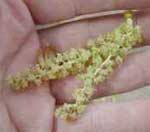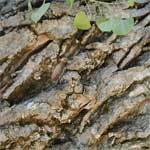
Fremont Cottonwood Tree
Scientific name: Populus fremontii
Alternate names: Valley Cottonwood, Rio Grande Cottonwood, Meseta Cottonwood, Western Cottonwood
Description: This is the cottonwood of desert waterholes and watercourses. A deciduous poplar of the Willow family with broad, flattened, open crown of large, widely spreading branches & trunk diameter of 2 to 5 feet. Easily propagated from cuttings, it is extensively planted in its range along irrigation ditches. Although it is a fast-growing shade tree, it is short-lived. It is named for its discoverer, Gen. John Charles Fremont (1813-1890), politician, soldier and explorer.

Fremont Cottonwood Flowers
Bark: On older trees, the bark is thick, deeply furrowed, reddish brown. On branches or on young trees, bark is thin, smooth and gray-brown.
Leaves: Roughly triangular in shape, 2 to 2.5 inches long and 2.5 to 3 inches wide. They are shiny green with a thin yellow midrib, a coarsely toothed margin & a yellow, flattened stem that causes the leaf to shake back & forth in the wind. Leaves turn bright yellow in autumn.
Twigs: light green, stout, hairless.

Fremont Cottonwood Leaves
Flowers: Catkins 2-3 1/2″ long, reddish; male and female on separate trees in early spring.
Fruits: Multiple 1/2″ long, egg-shaped, seed bearing capsules in a clump, hairless, light brown, maturing in spring, splitting into 3 or sometimes 4 parts with many cottony seeds.
Habitat: Wet soils along streams or near lakes in deserts, grasslands & woodlands
Range: S. and W. Colorado west to N. California and S.E. to Tran-Pecos Texas and Northern New Mexico to 6500 feet.

Fremont Cottonwood Seeds
Height: 40 to 80 feet
Elevation: Up to 6500 feet
Water Requirements: Moderate-High. Fremont cottonwood grows only on wet soil and is an indicator of permanent water and shade. In the desert, it needs weekly watering during hot weather if roots cannot tap the water table.

Fremont Cottonwood Bark
Wildlife: Horses gnaw the sweetish bark, beavers feed on the bark and build dams with the branches.

